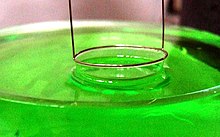In surface science, the du Noüy ring method is a technique for measuring the surface tension of a liquid. This technique was proposed by Pierre Lecomte du Noüy in 1925.[1] The measurement is performed with a force tensiometer, which typically uses an electrobalance to measure the excess force caused by the liquid being pulled up and automatically calculates and displays the surface tension corresponding to the force. Earlier, torsion wire balances were commonly used.

Description
editThe method involves slowly lifting a ring, often made of platinum, from the surface of a liquid. The force, F, required to raise the ring from the liquid's surface is measured and related to the liquid's surface tension γ:
where ri is the radius of the inner ring of the liquid film pulled, and ra is the radius of the outer ring of the liquid film.[2] wring is the weight of the ring minus the buoyant force due to the part of the ring below the liquid surface.[3]
When the ring's thickness is much smaller than its diameter, this equation can be simplified to
where R is the average of the inner and outer radius of the ring, i.e. [3][4]
The maximum force is used for the calculations, and empirically determined correction factors are required to remove the effect caused by the finite diameter of the ring:
with f being the correction factor.
Correction factors
editThe most common correction factors include Zuidema–Waters correction factors (for liquids with low interfacial tension), Huh–Mason correction factors (which cover a wider range than Zuidema–Waters), and Harkins–Jordan correction factors (more precise than Huh–Mason, while still covering the most widely used liquids).[5]
The surface tension and correction factors are expressed by
where γ is surface tension, R is the average diameter of the ring, and f is correction factor.
Zuidema–Waters correction factors
editH. H. Zuidema and George W. Waters introduced the following correction factor in 1961:[3]
where
- F = maximum pull of rings [dyn/cm],
- ρ = density of the lower and upper phases,
- a = 0.7250,
- b = 0.0009075 [s2⋅cm−1],
- r = Du Noüy wire radius,
- R = Du Noüy ring radius.
Huh–Mason corretion factors
editC. Huh and S. G. Mason[6][7] described the correction factors as a function of and See the references.
Harkins–Jordan correction factors
editWilliam Draper Harkins and Hubert F. Jordan[8][9] tabulated the correction factors as a function of and .
See also
editReferences
edit- ^ du Noüy, Pierre Lecomte (1925). "An Interfacial Tensiometer for Universal Use". The Journal of General Physiology. 7 (5): 625–633. doi:10.1085/jgp.7.5.625. PMC 2140742. PMID 19872165.
- ^ Butt, Hans-Jürgen; Graf, Karlheinz; Kappl, Michael (2003). "Physics and Chemistry of Interfaces": 14–15.
{{cite journal}}: Cite journal requires|journal=(help)[dead link] - ^ a b c Zuidema, H.; Waters, George (1941-05-01). "Ring Method for the Determination of Interfacial Tension". Industrial & Engineering Chemistry Analytical Edition. 13 (5): 312–313. doi:10.1021/i560093a009. ISSN 0096-4484.
- ^ "Total Weight of Ring using Ring-Detachment Method Calculator | Calculate Total Weight of Ring using Ring-Detachment Method". www.calculatoratoz.com. Retrieved 2024-05-29.
- ^ Udeagbara, Stephen Gekwu (2010-07-30). Effect of Temperature and Impurities on Surface Tension of Crude Oil. Universal-Publishers. ISBN 9781599423555.
- ^ Huh, C.; Mason, S. G. (1975-07-01). "A rigorous theory of ring tensiometry". Colloid and Polymer Science. 253 (7): 566–580. doi:10.1007/BF01753960. ISSN 1435-1536. S2CID 94325517.
- ^ Huh, C.; Mason, S. G. (1977-05-01). "A rigorous theory of ring tensiometry: Addendum on the wall effect". Colloid and Polymer Science. 255 (5): 460–467. doi:10.1007/BF01536462. ISSN 1435-1536. S2CID 97555566.
- ^ Harkins, William D.; Jordan, Hubert F. (1930-05-01). "A Method for the Determination of Surface and Interfacial Tension from the Maximum Pull on a Ring". Journal of the American Chemical Society. 52 (5): 1751–1772. doi:10.1021/ja01368a004. ISSN 0002-7863.
- ^ Harkins, William D.; Jordan, Hubert F. (1930-07-18). "Surface Tension by the Ring Method". Science. 72 (1855): 73–75. doi:10.1126/science.72.1855.73. ISSN 0036-8075. PMID 17819453.
External links
edit- Video showing a classical torsion wire du Noüy tensiometer
- Picture of a classical torsion wire du Noüy tensiometer (National Institutes of Health)